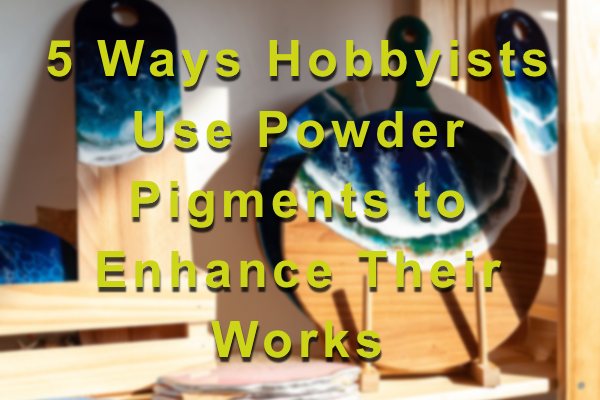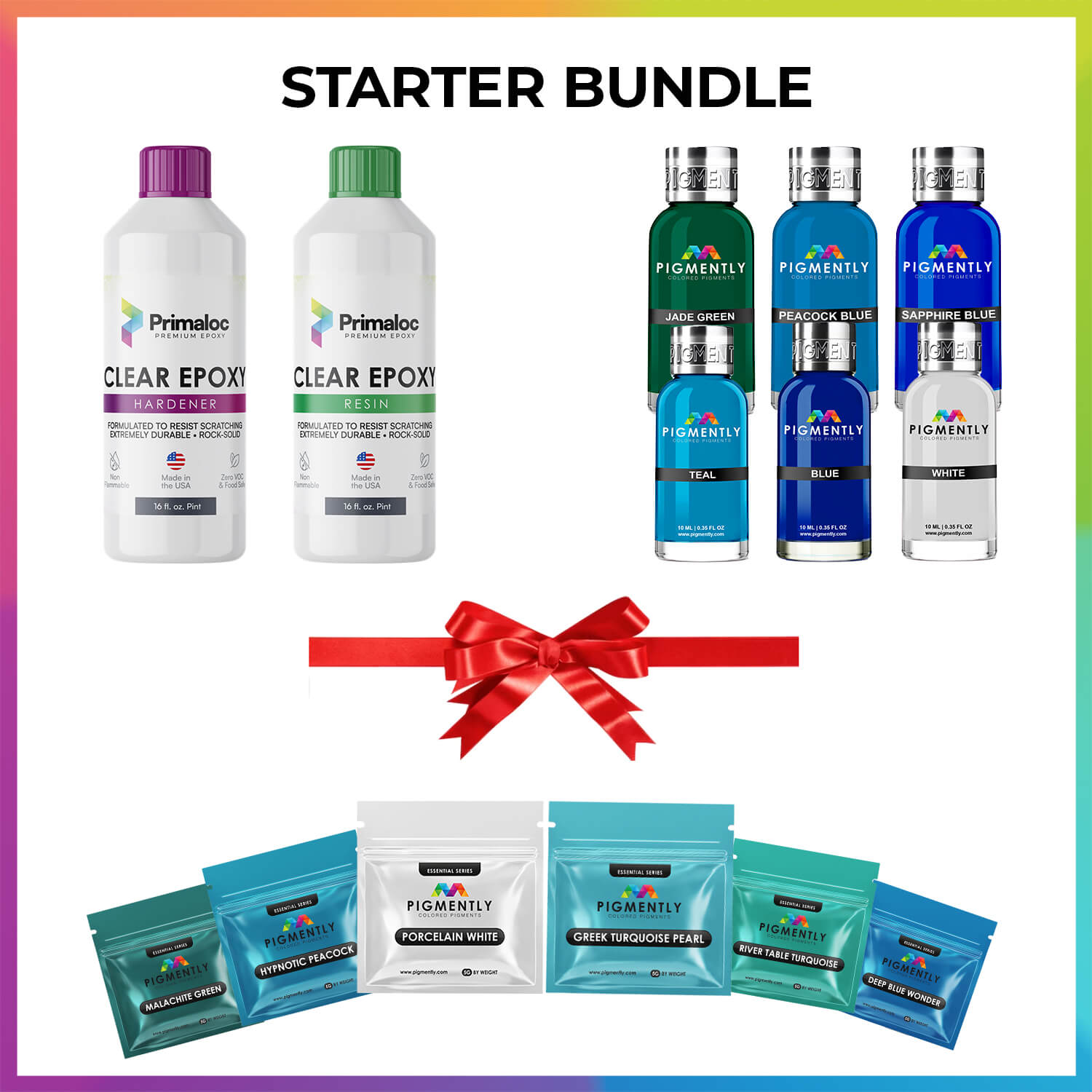In arts and crafts, having the right ingredients to generate the effects you're aiming for is essential. Regardless of your skill level—beginner, seasoned, etc.—it's the supplies you have that determine your limitations.
Many artists don't realize that some of the most vibrant visual effects were made possible by the use of unique colorants, such as powder pigments. These mineral-based colorants can be applied in so many ways to give the appearance of texture, vibrancy, and shine.
As such, they've become a popular optional ingredient for many types of crafts.
In this article, we'll discuss 5 of the ways that various hobbyists like to employ powder pigments in their endeavors to enhance their creative results.
5 Ways Hobbyists Use Powder Pigments to Enhance Their Works
It's easy to make use of powder pigments when working with any of these 5 crafting pastimes.
- Resin Art Creation
- Custom Paint Mixtures
- Ceramic Glazes
- Fabric Dyeing (and Textile Art)
- Other Decorative Crafts
Let's take a look.
Craft #1: Resin Art Creation
One of the most popular uses of powder pigments is in the creation of epoxy resin art. Artists can integrate these pigments into the resin to add color before it cures. The versatility of powder pigments allows for the creation of stunning visual effects such as marbling, gradient transitions, and even glowing effects under UV light. This technique is frequently used in making jewelry, decorative trays, and striking tabletops that showcase vivid colors and intricate designs locked within a glossy, glass-like surface.
Craft #2: Custom Paint Mixtures
DIY enthusiasts often use powder pigments to craft custom paint blends. Whether working with acrylics, oils, or watercolors, these pigments provide purity of color that pre-mixed paints sometimes lack. By adjusting the ratio of pigment to medium, artists can achieve the exact shade and opacity they require for a project. This customization is particularly appealing to model builders and canvas painters who need specific colors that match their vision perfectly.
Craft #3: Ceramic Glazes
Pottery and ceramic artists use powder pigments to color glazes and slips. Applying these colored glazes to pottery pieces before firing in a kiln allows the artist to create durable and unique color schemes that are heat-resistant and permanent. The pigments blend into the glaze, fusing to the ceramic as it bakes, resulting in vibrant, eye-catching finishes that enhance the artistic value of each piece.
Craft #4: Fabric Dyeing (and Textile Art)
Though not the primary method for commercial textile coloring, powder pigments are sometimes used in fabric dyeing projects by hobbyists. These pigments can be mixed with various substances to create fabric paints and dyes for hand-painted scarves, bespoke garments, and unique upholstery. The ability to mix custom colors lends itself well to projects requiring a specific color palette, such as cosplay outfits or thematic interior décor.

Craft #5: Other Decorative Crafts
Finally, powder pigments find a place in general decorative crafts where adding a splash of color can transform the ordinary into something extraordinary. Hobbyists sprinkle pigment powders onto wet adhesives to create colored designs on vases, frames, and furniture. Similarly, mixing pigments with mediums like epoxy or varnish can customize the look of wooden crafts, giving them an aged look or a bright, modern appeal depending on the chosen colors.
Powder Pigments Can Expand Your Creative Potential
As noted, the use of powder pigments allows hobbyists to achieve a level of customization and artistic freedom that pre-made materials cannot match. Not only do these pigments enhance the aesthetic of the projects, but they also allow artists to showcase their creativity in vibrant, colorful ways.
Whether used in small-scale home crafts or elaborate artistic endeavors, powder pigments help turn ethereal ideas into tangible art.
How to Use Powder Pigments in Each Craft
There are various methods for applying powder pigments within each of these crafting areas. Below, we'll give a basic technique for each one.
#1: Epoxy Resin:
Just after you finish mixing your resin batch, add some powder pigment, then mix it further. We recommend you start with a small amount, and add more as desired.
Just keep in mind that powder pigments are highly concentrated, but also that the resin will seem darker when it's all together in a container as opposed to spread out over a substrate or within a large resin mold. These can affect the appearance of the color intensity and opacity.
#2: Custom Paint Mixtures:
First, choose your medium (acrylic, watercolor, etc.); each will have its own texture and aesthetic.
Next, measure out the pigment you want. Start small at first, and be precise. You can use something like a precision scale or measuring spoon to aid in this; after that, add the pigment to your medium in a mixing container (or palette) and blend the contents together thoroughly. You can add more pigment as needed to achieve the desired color intensity.
Consider testing the paint occasionally to see if it looks right. When you're satisfied, store it in a sealable containe (or use it right away).
Note: Oil paint is tougher to mix so you may need to put in extra effort for a fine dispersion. Many users opt for a glass muller to force the mixture to blend.
#3: Ceramic Glazes
Acquire the glaze base and pigments you want to use.
When you're ready, measure your ingredients carefully, both the glaze and the pigments. Using a mixing container, add the pigment to your glaze base. Do it slowly and blend it together thoroughly. If the powder clumps, you can use a sieve to break it down. Repeatedly pass the mixture through the sieve until the color in the blend is evenly distributed.
From there, you can apply the glaze and continue with the process like normal.
Note: If you're not familiar with powder pigments already, it's a good idea to make a sample piece to test it out and get a sense of how much you need before committing to a full project.
#4: Fabric Dyeing
This one is a little more complicated and will instead get a full article later.
Pigmently: Your Trusted Source for Premium Pigments and Dyes
At Pigmently, our pigment products are all produced to high standards for quality and safety, ensuring long-lasting color that won't fade or morph. Each of our colorants has been carefully formulated to achieve high potency, with no fillers or subpar ingredients used during their creation.
When you buy Pigmently, you get not only a colorant of unparalleled quality but also the peace of mind that comes with choosing the best.
In our store, you'll find a wide array of mica powder pigments, with many different colors and textures available. We also offer a curated selection of potent dyes, which can be used to imbue your creations with subtle or intense tones.






